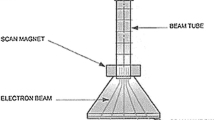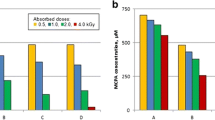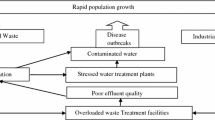Abstract
The radiolytic degradation of 2,4,6-trinitrotoluene and hexahydro-1,3,5-trinitro-1,3,5-triazine in individual aqueous solutions and in real wastewater was studied using the jet mode under an accelerated electron beam. The degree of mineralization of organic compounds and their biodegradability increased due to successive denitration, oxidation, and decarboxylation processes in solutions. The yields of radiolytic degradation of 2,4,6-trinitrotoluene and hexahydro-1,3,5-trinitro-1,3,5-triazine were about 0.027 and 0.064 μmol/J and the corresponding half-life doses were as high as 10 and 1.8 kGy, respectively. The high efficiency of the removal of 2,4,6-trinitrotoluene from real wastewater with the sequential use of coagulation, irradiation, and biological treatment was demonstrated.
Similar content being viewed by others
Explore related subjects
Discover the latest articles, news and stories from top researchers in related subjects.Avoid common mistakes on your manuscript.
In the production of 2,4,6-trinitrotoluene (TNT, trotyl) and hexahydro-1,3,5-trinitro-1,3,5-triazine (RDX, hexogen), wastewater is inevitably formed and it requires neutralization. Dissolved TNT and RDX are highly toxic and carcinogenic [1, 2]. They easily accumulate in soil, plants, and living organisms to cause mutations in the latter. Wastewater containing TNT and its derivatives is often referred to as TNT red water. Usually it is neutralized by evaporation and combustion methods. However, this treatment generates hazardous wastes (ash and gases) and requires too much heat. It is believed [1–3] that the use of biological treatment methods is more reasonable. However, the biodegradability of TNT and RDX is very low: the initial BOD/TOC and BOD/COD ratios (where BOD is the biochemical oxygen demand, TOC is the total organic carbon content, and COD is the chemical oxygen demand) for the solutions of TNT and RDX are lower than 0.1. Accordingly, biochemical treatment should be preceded by operations that increase the biodegradability of TNT red water components. Radiolysis can be considered as a method for the decomposition of organic nitro compounds [4–8] and a convenient way to increase the biodegradability of organic impurities in water [9]. In this work, we studied the effect of irradiation with accelerated electrons (hereinafter referred to as EBT, electron-beam treatment) on the composition and parameters of red water and model solutions of TNT and RDX.
EXPERIMENTAL
We investigated solutions containing 120 and 50 mg/dm3 of TNT and RDX, respectively, provided by a manufacturer of explosives in the Republic of Korea. The corresponding solubility limits of these compounds at 20°C are 130 and 60 mg/dm3, respectively. Total organic carbon (TOC) was determined on a Shimadzu 5000A TOC Analyzer. High-performance liquid chromatography (Hewlett Packard 1050 Series) was used to determine the concentrations of TNT, RDX, and organic acids. TNT and RDX in an acetonitrile phase were determined using an Acrodisc-13 syringe filter, 0.2 μm (Gelman Sciences, Ahn Arbor, MI) and reverse-phase C18 columns, 5 μm (ZORBAX SB-C18, Agilent Tech., Santa Clarita, CA). A C-610H column (Supelcogel, Bellefonte, PA) was used for the analysis of organic acids. The total analysis of organic products was carried out using GC/MS (electron impact) in accordance with published procedures [10]. The red water sample contained 4.1% Na2SO3, 6.0% NaNO3, 2.9% NaNO2, and about 12 wt % organic compounds and their salts (including 5.0% 2,4,5-TNT, 2.1% 2,3,4-TNT, 0.4% 2,3,6-TNT, 3.5% hexanitrobenzene, 0.2% trinitrobenzoic acid, 0.2% nitroformate, and trace 2,4,6-TNT). The initial characteristics of red water were the following: CODCr = 1490 ± 30 mg/dm3; BOD20 = 170 ± 13 mg/dm3; total nitrogen content TN = 690 ± 21 mg/dm3; color on the platinum–cobalt scale, 68 700 units; and suspended solids, 1350 ± 25 mg/dm3. Red water samples were irradiated after coagulation with Al2(SO4)3 and neutralization with NaOH. EBT in air was carried out in the jet mode [9] at a flow rate of 5 dm3/min. The initial dissolved oxygen concentrations in TNT and RDX solutions at pH 7 were 6.0 and 4.5 mg/dm3, respectively. The irradiator was an ELV direct-flow electron accelerator (2.5 MeV, 40 mA) located at EB Tech, Republic of Korea. The SO PD(F)R-5/50 (GSO [Certified Reference Material] 7865-2000) phenazine dye film dosimeter was used for dosimetry [11].
RESULTS AND DISCUSSION
The denitration of initial TNT and RDX with the conversion of bound nitro groups mainly into nitrates and ammonium and also trace nitrites belongs to the most important radiolytic transformations (Fig. 1). At low doses, the formation of nitrates is predominant. In turn, and increase in the ammonium content with dose is slower. This indicates that nitrate is one of the primary products, and ammonium is a secondary one. A decrease in the total concentration of all nitrogen species with dose indicates their partial conversion into volatile compounds. The formation of gaseous forms of nitrogen from nitrates due to their reactions with the reducing intermediates of water radiolysis was shown earlier [12, 13]:
Obviously, denitration is mainly due to the dissociative capture of hydrated electrons \({\text{e}}_{{{\text{aq}}}}^{ - }\) and \(\cdot {\text{H}}\) atoms:

(2)

(3)
Because no accumulation of nitrite was observed (Fig. 1), it is likely that the nitro group was eliminated in the form of a \(\cdot {\text{N}}{{{\text{O}}}_{{\text{2}}}}\) radical, which was then easily converted into nitrate in reactions with \(\cdot {\text{OH}}{\text{,}}\)\(\cdot {{{\text{O}}}_{{\text{2}}}}{\text{H}}{\text{,}}\) and Н2О2. The decay of H and OH adducts can also contribute to the denitration of TNT:

(4)
Figure 2 shows the degree of degradation of TNT and RDX at various absorbed doses. Undoubtedly, differences in the radiation resistance of TNT and RDX are primarily due to their structural differences. The presence of a conjugated aromatic structure makes TNT more stable. The half-conversions of TNT and RDX require about 10 and 1.8 kGy, respectively. These values correspond to the yields of degradation of 0.26 and 0.62 molecule/100 eV (0.027 and 0.064 μmol/J), respectively. These yields are typical of a complex reaction mechanism, which includes competing and reverse reactions [7, 8, 11]. The effective denitration of TNT and RDX was accompanied by a decrease in the total organic carbon (TOC) and chemical oxygen demand (COD). This fact indicates that the structure of organic molecules was destroyed and the degree of oxidation of the resulting products increased after denitration.
An important consequence of EBT was an increase in BOD and the formation of light organic acids (Fig. 3): oxalic and glyoxalic acids in the solution of TNT and formic acid in the solution of RDX. As noted above, the biodegradability of initial TNT and RDX is low. However, at a dose of 20 kGy, the BOD/COD ratio in the solutions of TNT and RDX became higher by factors of almost 8 and 15, respectively. An increase in biodegradability can be indicative of an increase in the degree of oxidation of the solute, as was previously observed for nitrogen-containing dyes [9]. The appearance of light organic acids indicated the breaking of skeletal bonds (C–C in TNT and C–N in RDX). At the same time, the accumulation of nitrate with increasing dose (Fig. 1) occurred much more easily than that of acids (Fig. 3) and ammonium. This means that nitrate was formed at earlier stages by a simpler mechanism. At low doses, nitrate accumulated almost linearly with increasing dose, while large doses led to a decrease in its concentration. This effect can indicate the involvement of secondary radiolytic products in the processes of nitrate degradation. Previously, it was found that dissolved nitrate is very resistant to radiolytic transformations due to the fact that process (1) with the participation of reducing intermediates is opposed by the following reverse process initiated by the oxidative intermediates (mainly the \( \cdot {\text{OH}}\) radical) of water radiolysis [12, 13]:
However, the presence of formate, which is a selective scavenger of OH radicals [12], facilitated an increase in the relative role of process (1) and, as a consequence, partial conversion of nitrate into volatile compounds. Obviously, in the case of the radiolysis of TNT and RDX, the appearance of glyoxalic, oxalic, and formic acids also weakened process (2). Moreover, the nonlinear dynamics of acid accumulation (Fig. 3) and a decrease in TOC (Fig. 2) with dose indicated the partial conversion into CO2 (decarboxylation) [12]. In contrast to nitrates, the composition of TNT and RDX molecules makes possible the selective scavenging of intermediates because \({\text{e}}_{{{\text{aq}}}}^{ - }\) and \( \cdot {\text{H}}\) more readily react with nitro groups, and hydrogen abstraction from alkyl groups and/or attachment to an aromatic ring are the predominant reactions of \( \cdot {\text{OH}}\) radicals.
The radiolytic degradation of TNT and RDX is a multistage process. The sequential appearance and disappearance of lighter products, which were detected by chromatography, with increasing dose was observed (Fig. 4). However, ultimately, organic products in the solutions of TNT and RDX at doses of 100 and 20 kGy, respectively, consisted of only light acids. The starting TNT and RDX are quite stable due to their symmetrical molecular structures. Radiolytic damage consists in a disturbance of this symmetry and, as a consequence, a redistribution of chemical bond strengths. Ring opening in TNT and RDX molecules, which causes the appearance of acids, can occur mainly due to the formation of a radical center in the ring. In TNT, such radical centers mainly arise as a result of the addition of H and OH. In RDX, cyclic radicals are formed mainly as a result of denitration and/or hydrogen abstraction by the OH or H radical. As a rule, bond breaking in the resulting radicals occurs in the β-position relative to the radical center

(6)

(7)
The above reactions result in the appearance of intermediates, whose further participation in radiolytic transformations ensures the formation of light organic acids and ammonium. Undoubtedly, the formation of acids is facilitated by the participation of dissolved oxygen in radiolytic transformations [12, 13].
Figure 5 shows the effect of EBT on a real red water sample in a combined treatment process. Red water was initially subjected to coagulation treatment (because of a high concentration of suspended solids) and then irradiated. It can be seen that the most significant changes in the composition of water occurred at the stages of radiolysis (100 kGy) and post-radiation biological treatment. The electron-beam treatment decreased COD by a factor of almost 2.4 and converted stable TNT derivatives into biodegradable species. In particular, nitrotoluenes (BOD/COD ≤ 0.1) were efficiently converted into light acids (BOD/COD ≈ 1). It should be noted that the effect of dose on the degradation of nitro-containing organic compounds was slightly weaker than that in the solution of TNT due to the initial presence of nitrates and nitrites. To minimize their effects, selective scavengers of OH radicals, for example, formate or oxalate, should be introduced into red water before practical irradiation.
CONCLUSIONS
The radiolysis of aqueous TNT and RDX solutions led to practically important processes. Mineralization occurred, as confirmed by a decrease in TOC and the simultaneous appearance of nitrate in solution. The conversion of stable organic components into a biodegradable form occurred, as demonstrated by the convergence of COD and BOD values. Finally, components were partially removed in the form of volatile compounds, as evidenced by a decrease in the TOC and TNT content. The solutions of TNT and RDX are successful systems simultaneously containing selective acceptors of a hydrated electron (nitro groups) and OH (alkyl groups). A stable mode of TNT and RDX neutralization was ensured by the fact that small organic acids, which resulted from hydrocarbon groups, played the role of selective acceptors of OH radicals as the solutes were exhausted. The high concentration of radiolytic radicals generated by an electron beam in water ensured the rapid completion of complex TNT and RDX conversions into biodegradable light acids and harmless volatile compounds. Accordingly, electron-beam treatment can serve as a useful step before the biological treatment of red water. This work demonstrates the improvement of EBT to the level of applied modeling of the neutralization of TNT, RDX, and red water using an industrial accelerator and a flow regime of irradiation.
REFERENCES
Khan, M.I., Lee, J., and Park, J., J. Microbiol. Biotechnol., 2012, vol. 22, no. 10, p. 1311.
Wang, Y., Zhang, L., Yang, L., and Chang, G., Chem. Eng. J., 2020, vol. 384, p. 123 358.
Khilyas, I.V., Lochnit, G., and Ilinskaya, O.N., Front. Microbiol., 2017, vol. 8, p. 2600.
Elovitz, M.S., Shemer, H., Peller, J.R., Vinodgopal, K., Sivaganesan, M., and Linden, K.G., J. Water Supply: Res. Technol.-Aqua, 2008, vol. 57, no. 6, p. 391.
Makarov, I.E., Zhestkova, T.P., and Zhukova, T.N., High Energy Chem., 2011, vol. 45, no. 2, p. 89.
Makarov, I.E., Protasova, E.L., and Khaikin, G.I., Russ. J. Phys. Chem. A, 2008, vol. 82, no. 11, p. 1833.
Wojnárovits, L. and Takács, E., J. Radioanal. Nucl. Chem., 2017, vol. 311, no. 2, p. 973.
Ershov, B.G., Usp. Khim., 2004, vol. 73, p. 107.
Han, B., Kim, J.K., Kim, Y., Choi, J.S., and Jeong, K.Y., Radiat. Phys. Chem., 2012, vol. 81, no. 9, p. 1475.
Standard Methods for the Examination of Water and Wastewater, 23rd ed., Washington, DC: APHA–AWWA–WPCF, 2017.
Pikaev, A.K., High Energy Chem., 2000, vol. 34, no. 2, p. 55.
Makarov, I.E. and Ponomarev, A.V., Ionizing Radiation Effects and Applications, Djezzar, Ed., Rijeka: InTech, 2018, ch. 5. https://doi.org/10.5772/intechopen.72074
Ponomarev, A.V., Bludenko, A.V., and Makarov, I.E., Mendeleev Commun., 2002, vol. 12, no. 3, p. 92.
Author information
Authors and Affiliations
Corresponding author
Additional information
Translated by V. Makhlyarchuk
Rights and permissions
About this article
Cite this article
Yuri Kim, Ponomarev, A.V. & Ershov, B.G. Electron-Beam Water Cleaning from 2,4,6-Trinitrotoluene and Hexahydro-1,3,5-Trinitro-1,3,5-Triazine. High Energy Chem 54, 358–362 (2020). https://doi.org/10.1134/S0018143920050094
Received:
Revised:
Accepted:
Published:
Issue Date:
DOI: https://doi.org/10.1134/S0018143920050094









